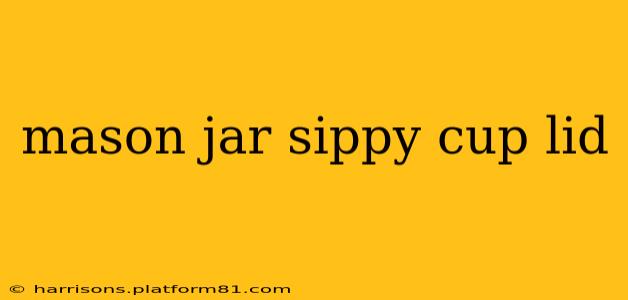Mason jars are incredibly versatile, and with the right lid, they can transform into convenient and charming sippy cups for little ones. But navigating the world of mason jar sippy cup lids can be tricky. This guide explores everything you need to know, answering common questions and helping you choose the perfect lid for your needs.
What are Mason Jar Sippy Cup Lids?
Mason jar sippy cup lids are specialized closures designed to fit standard-sized mason jars, turning them into reusable and spill-proof sippy cups. Unlike regular mason jar lids, these lids feature a sippy cup spout, often with a valve to prevent leaks. They are generally made from food-grade silicone or plastic, ensuring safety for your child. They offer a sustainable and often more affordable alternative to buying disposable sippy cups.
What are the Different Types of Mason Jar Sippy Cup Lids?
There's a surprising variety in mason jar sippy cup lids available. They differ primarily in material, spout design, and features.
- Silicone Lids: These are generally considered the safest option, being BPA-free and often dishwasher safe. They are also usually more durable than plastic lids.
- Plastic Lids: These can be more affordable but may not be as durable or long-lasting as silicone lids. Always check for BPA-free labeling.
- Spout Styles: You'll find lids with various spout designs, including soft silicone spouts for babies, harder spouts for toddlers, and even straw lids for older children. Consider your child's age and developmental stage when choosing.
- Features: Some lids come with additional features such as handles for easy gripping, leak-proof seals, and even built-in carrying loops.
What Size Mason Jars Work Best with Sippy Cup Lids?
While many lids claim compatibility with "standard" mason jars, it's important to check the manufacturer's specifications. Most commonly, these lids are designed for regular mouth mason jars (the most common type), but some are also made for wide-mouth jars. Always double-check the lid's packaging or product description to ensure a proper fit with your jars. Pay close attention to the jar's diameter.
Are Mason Jar Sippy Cup Lids Safe for Babies?
This depends heavily on the lid itself. Look for lids made from food-grade silicone or BPA-free plastic. Ensure the spout is appropriately sized and designed for a baby's mouth to prevent choking hazards. Always supervise your baby while they are using a mason jar sippy cup.
How Do I Clean Mason Jar Sippy Cup Lids?
Cleaning is crucial for hygiene. Most silicone and plastic lids are dishwasher safe (check the manufacturer's instructions). However, hand washing is always an option for more delicate lids or to ensure thorough cleaning. Regularly inspect the lid for any damage or wear and tear. Replace the lid if it shows signs of damage.
Where Can I Buy Mason Jar Sippy Cup Lids?
These lids are widely available online from retailers like Amazon, Etsy, and specialized baby product stores. Many smaller businesses also craft and sell handcrafted mason jar sippy cup lids. You can also find them in some brick-and-mortar stores specializing in home goods or kitchen supplies.
What are the Benefits of Using a Mason Jar Sippy Cup?
Using mason jars as sippy cups offers several advantages:
- Sustainability: Reusable mason jars reduce waste compared to disposable sippy cups.
- Affordability: Often, buying mason jars and lids is cheaper than repeatedly purchasing disposable sippy cups.
- Versatility: Mason jars can be used for various purposes beyond sippy cups, extending their lifespan.
- Durability: High-quality mason jars are very durable and can last for years.
By carefully considering the type of lid and features, you can find the perfect mason jar sippy cup solution for your child, offering a safe, sustainable, and affordable alternative to traditional sippy cups. Remember always to prioritize safety and choose a lid that's appropriate for your child's age and developmental stage.
